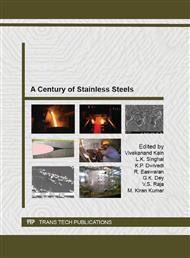[1]
H. Solomon, T. Divine, Tale of two phases, in: Jr., R.A. Lula, (Ed. ), Duplex stainless steels, American Society for Metals, Ohio, 1983, pp.693-756.
Google Scholar
[2]
K.N. Adhe, V. Kain, K. Madangopal, H.S. Gadiyar, Influence of sigma-phase formation on the localized corrosion behaviour of a duplex stainless steel, J. Mater. Eng. Perform. 5 (1996) 500-506.
DOI: 10.1007/bf02648847
Google Scholar
[3]
F.C. Hull, Delta ferrite and martensite formation in stainless steels, Weld J. 52 (1973) 193-203.
Google Scholar
[4]
J. O. Nilsson, Super duplex stainless steels, Mater. Sci. and Tech. 8 (1992) 685-700.
Google Scholar
[5]
M. Pohl, O. Storz, T. Glogowski, Effect of intermetallic precipitations on the properties of duplex stainless steel, Mater. Character. 58 (2007) 65-71.
DOI: 10.1016/j.matchar.2006.03.015
Google Scholar
[6]
C.J. Park, V. Shankar Rao, H.S. Kwon, Effects of sigma phase on the initiation and propagation of pitting corrosion of duplex stainless steel, Corrosion 61 (2005) 76-83.
DOI: 10.5006/1.3278163
Google Scholar
[7]
N. Ebrahimi, M. Momeni, M. H. Moayed, A. Davoodi, Correlation between critical pitting temperature and degree of sensitization on alloy 2205 duplex stainless steel, Corros. Sci. 53 (2011) 637-644.
DOI: 10.1016/j.corsci.2010.10.009
Google Scholar
[8]
K. Ravindranath, S. N. Malhotra, Influence of aging on the intergranular corrosion of 22 chromium-5 nickel duplex stainless steel, Corros. Sci. 37 (1995) 121-132.
DOI: 10.1016/0010-938x(94)00120-u
Google Scholar
[9]
G.C. Palit, V. Kain, H.S. Gadiyar, Electrochemical investigations of pitting corrosion in nitrogen bearing type 316 LN stainless steel, Corrosion 49 (1993) 977-991.
DOI: 10.5006/1.3316025
Google Scholar
[10]
A. Davoodi, J. Pan, C. Leygraf, S. Norgren, Probing of local dissolution of Al-alloys in chloride solutions by AFM and SECM, Appl. Surf. Sci. 252 (2006) 5499-5503.
DOI: 10.1016/j.apsusc.2005.12.023
Google Scholar
[11]
R.M. Souto, Y. Gonza´ lez-Garcı´a, S. Gonza´ lez, G.T. Burstein, Damage to paint coatings caused by electrolyte immersion as observed in situ by scanning electrochemical microscopy, Corros. Sci. 46 (2004) 2621-2628.
DOI: 10.1016/j.corsci.2004.06.002
Google Scholar
[12]
C.H. Paik, H.S. White, R.C. Alkire, Scanning Electrochemical microscopy detection of dissolved sulfur species from inclusions in stainless steel, J. Electrochem. Soc. 147 (2000) 4120-4124.
DOI: 10.1149/1.1394028
Google Scholar
[13]
T.E. Lister, P.J. Pinhero, T.L. Trowbridge, R.E. Mizia, Localized attack of a two-phase metal, scanning electrochemical microscopy studies of NiCrMoGd Alloys J. Electroanal. Chem. 579 (2005) 291–298.
DOI: 10.1016/j.jelechem.2005.02.019
Google Scholar
[14]
V. Cihal, T. Shoji, V. Kain, Y. Watanabe, R. Stefec, Electrochemical polarization reactivation technique- A comprehensive review, FRRI publishers, Sendai, (2004).
Google Scholar
[15]
C.F. Dong, H. Luo, K. Xiao, X.G. Li, Y.F. Cheng, In Situ characterization of pitting corrosion of stainless steel by a scanning electrochemical microscopy, J. Mater. Eng. Perform. 21 (2011) 406-410.
DOI: 10.1007/s11665-011-9899-y
Google Scholar
[16]
S. K. Ghosh, S. Mondal, High temperature aging behaviour of a duplex stainless steel, Mat. Character. 59 (2008) 1776-1783.
DOI: 10.1016/j.matchar.2008.04.008
Google Scholar
[17]
T. H. Chen, J.R. Yang, Effects of solution treatment and continuous cooling on σ-phase precipitation in a 2205 duplex stainless steel, Mater. Sci. Eng. A 311 (2001) 28-41.
DOI: 10.1016/s0921-5093(01)00911-x
Google Scholar
[18]
Jia Gong, Y.M. Jiang, B. Deng, J.L. Xu, J.P. Hu, Jin Li, Evaluation of intergranular corrosion susceptibility of UNS S31803 duplex stainless steel with an optimized double loop electrochemical potentiokinetic reactivation method, Electrochim. Acta 55 (2010).
DOI: 10.1016/j.electacta.2010.03.086
Google Scholar
[19]
Yuehua Yin, Lin Niu, Min Lu, Weikuan Guo, Shenhao Chen, In situ characterization of localized corrosion of stainless steel by Scanning electrochemical microscopy, Appl. Surf. Sci. 225 (2009) 9193-9199.
DOI: 10.1016/j.apsusc.2009.07.003
Google Scholar


